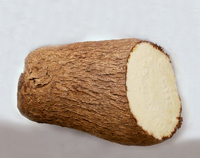Most of you who know me, know that I am total nerd when it comes to food. That being said, after a quick Google search, I found this completely interesting and enlightening article. Read on and, for those of you who suffer from a confusion akin to my own, learn the fascinating difference between Yams and Sweet Potatoes so that you too can join the throng of consumers out to "rid the world of yam ignorance." :) Enjoy!
*I personally got a huge kick out of the serious, life-or-death-ness of the article--
Informative AND funny- what a culinary bonus!
The Difference Between A Sweet Potato And A Yam Is No Joke!
Some people think they’re the same thing. Even producers stencil both names on the same box, since the U.S. Department of Agriculture requires that the label “yam” always be accompanied with the words “sweet potato” when referring to a sweet potato. No wonder the poor consumer is confused. Hasn’t anyone told the USDA that these are separate vegetables that are not in the least related? Why should “yam” be on a sweet potato box in the first place.
The confusion began in the Antebellum era. The African slaves called the softer sweet potatoes cultivated in America “yams” because they resembled the nyami they knew from home. There were no nyami in America at the time: African and Caribbean immigrants wouldn’t cause import of real nyami, the white-fleshed African yam, to America until the latter 20th century, when they would appear in international grocery stores. By that time, most of America had only known “yams” as yellow-fleshed potatoes that weren’t particularly sweet. Some myths went so far as to say that yams were older sweet potatoes, after the sugar had converted to starch and the more colorful flesh had faded.
The Confusion Continues
Those encountering the long, rough, brown tubers called yams in international markets–or ordering yams in Caribbean restaurants and getting something white and starchy—have every right to be thoroughly confused. We are living in a multi-yam society. Perhaps it‘s time to go back to the terms sweet potato (domestic) and yam (African); or at least, domestic yam (sweet potato) and African yam (true yam).
The Final WordHere’s a comparison to master; then you can help rid the world of yam ignorance. | | Sweet Potato & Domestic Yam | True Yam | | |  |  | | Scientific Name | Ipomoea batatas | Dioscorea Species | | Plant Family | Morning Glory (Convolvulaceae) | Yam (Dioscoreaceae) | | Origin | South America (Peru, Ecuador) | West Africa, Asia | | Age | Prehistoric | 50,000 B.C.E. | | Skin | Smooth and thin; yellow/tan to darker orange/tan, red and purple | Rough and scaly; the color is brown or brownish-black | | Flesh | The color can range from white to yellow, orange, or orange-red | Generally white, although some varieties can have purple or red flesh | | Shape | Short, blocky, tapered ends | Long, cylindrical, some with “toes”; often sold in chunks, since they can grow to 7 feet in length | | Mouthfeel | Moist* | Dry | | Taste | Sweet* | Starchy | | Calories, ½ Cup | 103 | 79 | | Provenance | United States | Caribbean | | Varieties | Sweet potatoes: Jersey, Kotobuki (Japanese), Okinawan (Purple), Papa Doc
Yams: Beauregard, Covington, Garnet, Jewel | There are about 500 species of the genus Dioscorea of the Dioscoreaceae family |
*Most varieties grown in the U.S. © Copyright 2005- 2010 Lifestyle Direct, Inc. All rights reserved. Images are the copyright of their respective owners. Taken from thenibble.com

|  |





2 comments:
sgood heavens! i can't tell you how many times i have gone to the store and asked a produce dude to point me in the right direction of the veggie i was looking for only to end up getting the 'the other' one (yam vs sweet potato). good read AND all produce dudes out there should keep some type of refence guide in their pockets that resemble this!
I couldn't agree more! Also- so happy to know I'm not the only food nerd out there. ;)
Post a Comment